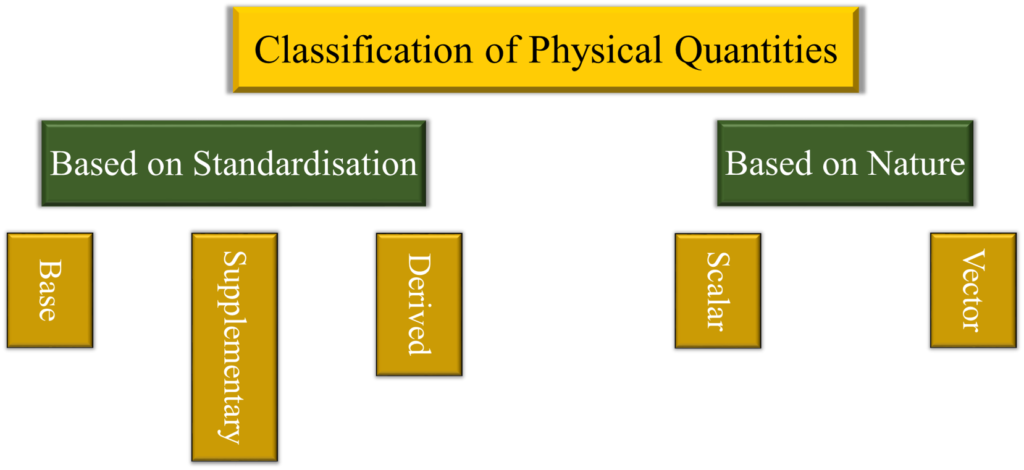Classification of physical quantities is central to our understanding of the world. It helps us to describe and quantify the physical properties of objects and phenomena. It is a universal language for scientific communication and experimentation.
Table of Contents
Introduction
In the physical world, there are both measurable or quantifiable aspects and abstract aspects. These aspects shape our understanding of reality. For anyone interested in sciences – in particular physics, chemistry, and engineering – understanding of these aspects is very important.
For instance, in our everyday lives, we often deal with various measurable quantities like:
We also encounter abstract quantities like:
- fear
- beauty
- happiness
- intelligence
- motivation
But have you ever wondered what makes these experiences and measurements meaningful?
Here, we shall find this out.
Non-Physical Quantity
“An idea or a feeling that cannot be measured with tools or instrument and has no standard unit.”
A non-physical quantity entails a concept that reflects internal states or abstract ideas. Even though they cannot be quantified. They are crucial in fields like psychology and sociology.
Example
- Happiness
- Intelligence
- Motivation
Physical Quantity
“A property of an object or phenomenon that can be measured easily is called a physical quantity.”
It is fundamental in science as it helps us to describe and quantify aspects of the world around us. They are essential for accurate scientific measurement, allowing us to describe and analyse the physical world in a standardised way.
Example
The physical examination of a student may involve following quantities:
- mass
- height
- time (age)
- temperature
- etc.
Classification of Physical Quantities
These quantities can be classified on different basis as shown below:

Requirements of a Physical Quantity
For a quantity to be a physical quantity, the following must be true:
Measurable
It should be possible to measure the quantity using standard methods or instruments.
Quantifiable
It must be expressible in numerical terms, such as 5 meters or 20 degrees Celsius.
Standardised
It should be defined using standard units so that measurements are consistent and comparable.
Scalability
The quantity must be capable of being scaled up or down using prefixes.
For example, mass can be measured in grams, milligrams, or kilograms etc.
Universality
The quantity should be universally applicable and understandable.
For example, time is measured in seconds or minutes, making it comprehensible globally.
What Does a Physical Quantity Entail?
A physical quantity entails three important key aspects:
Type of Property
Refers to the property being measured, whether it is a base or derived quantity (e.g., length, area, or volume).
Magnitude
The size or amount of the quantity (e.g., 10 litters).
Unit
The standard measure in which the quantity is expressed (e.g., meters, kilograms).
Nature of Quantity
Whether the quantity is scalar (having only magnitude) or vector (having both magnitude and direction).
Significance of Physical Quantities
Physical quantities come in handy in both real life and scientific purposes.
- They make our trading activities simpler, universal and understandable.
- They provide us a standardised system for measuring physical properties.
- They form the backbone of how we understand and interact with the physical universe.
- They simplified the way we communicate scientific results or perform complex calculations.
Conclusion
Physical quantities are not only essential for accurately describing and measuring the world but also help us navigate and interpret the physical world.
In the realm of science and engineering, measurement is everything. Whether we are calculating the speed of a vehicle, determining the temperature of a substance, or figuring out the pressure inside a container, we are dealing with physical quantities.
On the other hand, non-physical quantities like happiness, fear, and creativity cannot be measured directly. They are subjective and often assessed through observation or self-reports. Unlike physical quantities, they lack standard units and vary based on individual and cultural perspectives.
By breaking down quantities into base, derived, and supplementary types, we gain a clearer picture of how various properties interact and are measured.
At the same time, classifying the physical quantities as scalar and vector provide us a way to analyse different physical phenomena more accurately.
Whether we are calculating the speed of a moving car or taking into consideration its orientation or direction, knowing these basic concepts will help you make sense of the measurements we encounter every day.
These fundamental concepts are the tools to measure, analyse, and communicate complex phenomena with clarity and precision.
Frequently Asked Questions (FAQs)
What is a physical quantity?
A physical quantity is a measurable property of an object or phenomenon, such as length, mass, time, or temperature, which can be quantified using numbers and units.
Why are physical quantities important in science?
Physical quantities allow scientists to make precise and consistent measurements, enabling them to communicate results, perform calculations, and develop theories about the natural world.
What are the two main categories of physical quantities?
Physical quantities are mainly classified into base quantities and derived quantities. Base quantities are fundamental, while derived quantities are created by combining base quantities.
What are examples of base quantities?
Examples of base quantities include length (measured in meters), mass (measured in kilograms), and time (measured in seconds).
How are derived quantities different from base quantities?
Derived quantities are formed by mathematical combinations of base quantities. For example, speed is derived by dividing distance by time, and it’s measured in meters per second.
What are supplementary quantities in physics?
Supplementary quantities refer to additional quantities used in specialized fields of physics, such as plane angle (measured in radians) and solid angle (measured in steradians).
How do you measure physical quantities?
Physical quantities are measured using standard instruments and methods. Each quantity has a specific unit, like meters for length or seconds for time, ensuring that measurements are consistent across different contexts.
What is the role of standard quantities in science?
Standard quantities provide a reference point for measurements, ensuring accuracy and uniformity across different scientific experiments and calculations. Without standards, measurements would be inconsistent.
Can physical quantities be negative?
Yes, some physical quantities, such as velocity or electric charge, can have negative values depending on the direction or nature of the phenomenon being measured.
Why do we need units when measuring physical quantities?
Units give meaning to the numbers in measurements. Without units, the numbers would have no context, making it impossible to interpret the magnitude of the quantity being measured.

I found it very organized and important for my better understanding of the concept of PHYSICAL QUANTITY especially its classification requirements
Thank you for the appreciation. Feel free to explore more